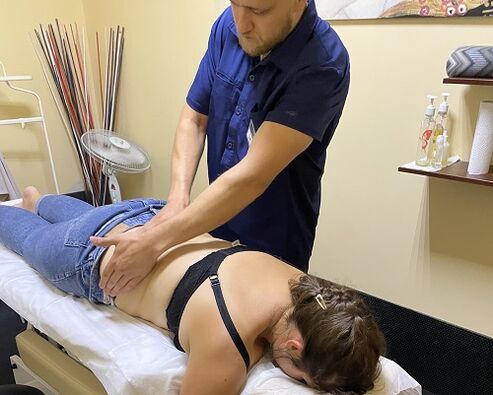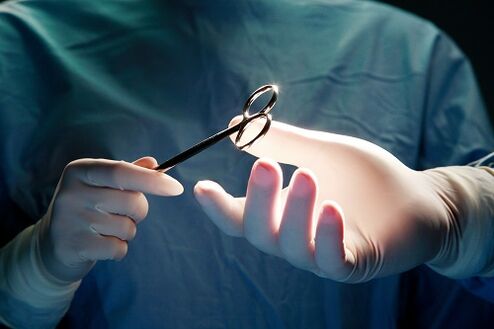
Osteochondrosis of the cervical spine is common today among city dwellers, office workers and people who spend several hours a day in the same position.
But it can also develop in youth. Therefore, everyone should know what cervical osteochondrosis is and how it is treated in order to seek help in time and prevent the development of unpleasant symptoms and destruction of the neck and shoulder joints.
Before deciding what to do if osteochondrosis of the cervical spine worsens and there is pain in the neck, you need to consult a doctor and make a diagnosis.

Diagnosis
Is it possible to permanently cure osteochondrosis of the cervical spine, is it possible to treat the neck and how to do it, the doctor will tell you after a complete diagnosis has been made. Due to the similarity of symptoms with other diseases, attention is paid to determining the diagnosis. A patient who comes to a neurologist with complaints of neck pain and dizziness will have to go through several stages before a complex therapy is developed for him.
Inspection
During the first visit to the neurologist, an initial examination of the patient is carried out. The doctor's task is to determine the diagnosis, the possible cause of the appearance and development of the disease, and also to exclude other diseases with similar symptoms.
Expert during inspection:
- Hears complaints about health. Clarifies symptoms, frequency, intensity. Try to determine what triggers the onset of the attack.
- Clarify the details of the anamnesis,will determine the characteristics of the patient's daily life and the presence of concomitant diseases.
- Checks the functioning of reflexes,focusing on those whose work is influenced by the nerve endings located in the neck.
- Examines muscle strength and sensitivity,will identify areas of numbness or a tendency to spasms or excessive relaxation.
- Will drivevestibular apparatus tests,which is also affected by the development of osteochondrosis.
During the process, the doctor examines the condition of the muscles. Its thinness or swelling indicate problems with nervous sensitivity. Another important symptom is pain and dizziness when turning or tilting the head.
Laboratory diagnosis

It is possible to prescribe an error-free treatment regimen during exacerbation of cervical osteochondrosis and provide effective assistance only by identifying the causes of destruction of the vertebrae and intervertebral discs. And for this, additional research is carried out in the laboratory.
To understand the development of the disease, several studies are carried out:
- Total and ionized calcium.
- Osteocalcin and osteoprotegerin– substances – indicators that bones are gradually being destroyed and cartilaginous tissue is becoming thinner. If its amount in the blood is higher than normal, the disease will continue to develop.
- Creatine kinase– an indicator of damage to muscle tissue. If osteochondrosis has already provoked the development of myositis and seriously threatens the muscles, this indicator in the blood will also increase.
- Research on microelements and vitaminsis carried out to determine which microelements and vitamins necessary for metabolism and tissue repair are lacking in the patient's body.
Instrumental studies
After knowing the rate of development and causes of chondrosis, the doctor must determine the state in which the patient was admitted.
To this end, hardware studies of the spine and intervertebral discs are carried out:
- Radiography.It presents serious changes in the bone structure, resulting in deformations and neoplasms.
- Magnetic resonance imagingevaluates the condition of nerve roots, bulging discs, vertebral inversions, and small tumors.
- Ultrasound of cervical blood vesselsblood vessels is carried out to determine their patency and, therefore, the ability to supply the brain with the necessary oxygen and nutrients.
- Electroneuromyography.A current charge passes through the nervous system, which is unpleasant, but it shows the level of passage of nerve impulses and the speed of their passage to the muscles, and therefore the degree of damage.

There are many tips on how to get rid of cervical osteochondrosis forever, quickly relieve pain, eliminate dizziness and fight attacks of weakness at home. But it is necessary to understand that this is a serious disease that develops individually and therefore the treatment regimen must be chosen by a professional. Therefore, when the first symptoms appear, without wasting time on traditional methods, you should contact the clinic.
Treatment
Almost everyone who was diagnosed with "chondrosis of the cervical spine" thought about how to cure the degenerative disease, whether it can be treated and how, and whether it is possible to forget about neck pain forever if you follow the advice of doctors. The answer depends on the stage.
In the first and second stages, there are methods that allow the treatment of chondrosis of the cervical spine in men and women with good results for the neck at home.
The doctor's goal is to relieve pain, prevent further destruction of cartilage and bone tissue, and try to restore, if possible, the intervertebral discs to restore mobility. To solve this problem, complex therapy is always used, but sometimes surgical intervention is added to conservative treatment methods.
Drug treatment
Often, men and women, faced with the worsening phase of inflammation due to osteochondrosis of the cervical spine, opt for treatment at home, with a strong analgesic, but what to do if the pain in the neck returns, which treatment will be effective? The only correct answer is to consult a neurologist.
When chondrosis worsens, it is important not only to eliminate the symptoms, but also to cure what causes them, and therefore the range of medications is not limited to painkillers.For the treatment of cervical osteochondrosis the following are used:
- Nonsteroidal anti-inflammatory drugs,helping to relieve pain and reduce tissue inflammation at the site of compressed nerve endings.
- Local gels and ointments,which must be prescribed by a doctor, as not all are compatible with medications taken orally.
- Muscle relaxantswill allow you to relax spasmodic muscles and release compressed nerves and arteries, getting rid of stiffness, pain and dizziness.
- Chondroprotectorsare used to prevent the destruction and restore the cartilaginous tissue of intervertebral discs and prevent the occurrence of hernias.
- Vitamin complexesThey are used to improve tissue nutrition, accelerating their recovery, and enhance the effect of medications, allowing the use of smaller doses.
If the patient is admitted with unbearable pain, a blockade based on hormonal analgesics will be used.

Non-drug treatment
Another method that has excellent reviews from men and women and is often used to treat osteochondrosis of the cervical spine and shoulder girdle at home is physiotherapy, but how and with what to treat it must also be decided by the doctor. After all, there are no universal physiotherapy methods that suit everyone. A set of effective methods is selected specifically for each patient.
The most effective are considered:
- Electrophoresis with analgesics.
- Physiotherapy. The set of exercises and their complexity vary depending on the stage of development of osteochondrosis.
- Massage and self-massage.
- Magnetotherapy.
Surgery for osteochondrosis
At certain stages of the development of cervical osteochondrosis, what is prescribed for pain in the neck and back does not help, in which case you can take heavier medications or resort to a radical but effective method - surgery. The operation is prescribed for patients with irreversible changes in the structure of the spine. At the same time, collapsed and fused vertebrae, hernias and neoplasms that appear threaten human life and reduce its quality.

The surgeon will be able to remove bone growths, hernias, tumors and pinched nerve endings. After such an intervention, the patient will undergo rehabilitation, during which it is necessary to follow the doctor's recommendations, otherwise even the operation will not bring the desired effect.
How and how to treat cervical chondrosis at home or in the hospital, what to do to relieve pain in the neck and shoulders, get rid of dizziness and relieve inflammation of the vertebrae, what helps and what is harmful, the doctor must decide. When using other methods and means, you risk your health, because with such a disease, therapy must be built taking into account the patient's personal characteristics.
Prevention
In order not to know what the treatment for cervical osteochondrosis is, you should think about prevention in advance. The disease is often hereditary, but following the recommendations will prevent the disease from developing or stop it in its early stages.
Traditional preventive measures for spinal diseases:
- Ensure healthy physical activity. Light workouts 2 to 3 times a week. It is worth choosing a sport aimed at strengthening the muscular corset. Swimming, yoga, Pilates, cycling and skating are suitable. In this case, the loads should not be too heavy.
- Daily activity even during sedentary work. To do this, just exercise and go for walks.
- Monitor your posture, not only when walking, but also while working.
- An ergonomic workplace where the space that occupies attention is located so that the neck is not strained.
- Avoid heavy lifting and excessive physical exercise.
- Provide a comfortable place to sleep with an orthopedic mattress and pillows so that sleep is healthy and provides complete rest.
- Give up bad habits, as alcohol, nicotine and drugs have an extremely negative effect on joints, bones and blood vessels.
- Change your diet. It is worth reducing the amount of salt, spices, sugar and flour consumed in the daily menu. Avoid fast food, especially those cooked in oil, sweet sodas and juices.
- Make a menu taking into account the need for microelements and vitamins. Pay attention to vegetables and fruits, fish and lean meats.
- Drink clean water in sufficient quantities.
- Once every few months, get a maintenance massage. Do self-massage regularly if you feel tired in the shoulder area.
If, despite all attempts to maintain health, osteochondrosis of the cervical spine appears, only a doctor can determine how long the disease will be treated after a complete diagnosis. However, to prevent the recurrence of an exacerbation, a person with such a diagnosis will have to remember the rules of healthy living throughout his life.

























